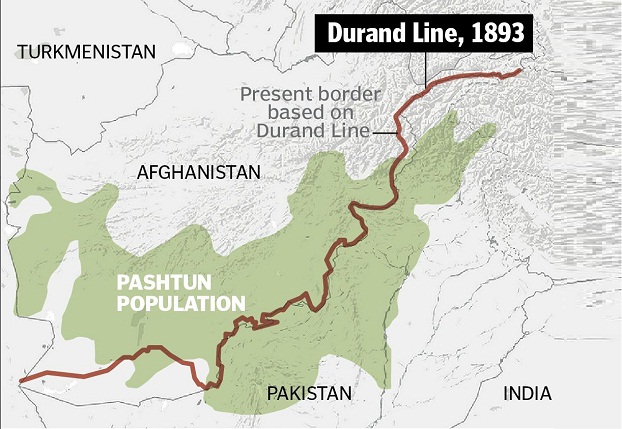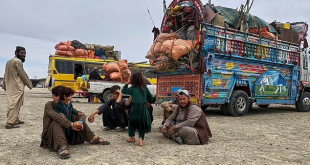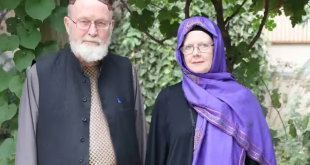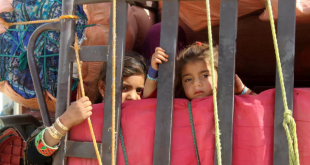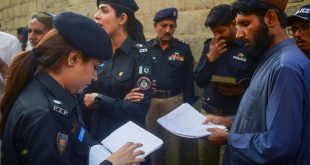Prof. Noor Ahmad Khalidi, Translated by Rafiullah Anwari
We have previously discussed that the Durand line becomes unrecognized after the death of Afghan King (Emir) Abdul Rahman Khan. (His son) Emir Habibullah Khan was forced by British India (British Raj) to sign recognition of the line in 1905 which is also no longer valid after his death in 1919. But British India included the prolonging of the line in a ceasefire agreement of Rawalpindi of August 8th, 1919. The temporary Kabul agreement of three years in 1921 replaces the Rawalpindi deal.
British remained committed to the 1921 deal till 1949, until the formation of Pakistan, especially when Pakistan bombarded the southern province of Paktia, the Afghan government in a National Assembly (Loya-Jirga) canceled all of the agreements with the British Raj, and therefore, all deals related to the Durand line were all terminated.
Regarding the claim of Ahmad Sayede of saying that “based on the 69 and 74 resolutions of the United Nations the Durand line deal is time-based and that it is an already-resolved issue as it completed 100 years.” It is an inaccurate claim! There is no such issue-of what Ahmad Sayede claimed off- in the UN resolution about the international agreements. From 69 to 72 resolutions of the UN belong to the second part which is related to United Nations Economic and Social Council and also the 74 resolution does not include the international agreements.
What we can consider is that the United Nations (1969) Convention of Law of Treaties whose 45th resolution declares the agreements signed after 1969 as time-based. This convention does not refer to its previous time, and therefore, this resolution is not accomplishable on the Durand line and the deal of 1921.
1- Afghan governments’ stance regarding Durand line
After 70 years of the Afghanistan statement published in 1949 on the cancelation of deals with Britain, it (statement) still remains emboldened. The US then prevented the referring of the issue (Durand line) to the UN. After then, no Afghan kingdom and government (Since the Republic Government of Daud Khan, the Afghanistan Communist Parties of Khalq and Parcham, Mojaddedi’s Islamic Government, Rabbani Islamic Government, Taliban Islamic Emirate, and Current Administration) has not recognized the Durand line as a borderline with Pakistan.
2- Britain’s stance regarding Durand line
When Shah Mahmood Khan was appointed as Afghanistan Prime Minister by King Mohammad Zahir Shah in 1946, he sent a letter to British India, asking for the fate of the people on the other side of the Durand line. In the wake of India’s separation then, he asked the British government to “provide an opportunity for Pashtuns and Baluchis to form their government or rejoin with Afghanistan.” But, the British in response said that the “issue of the free borders was an already solved issue and Durand line is recognized as an international border. The 1921 agreement is still implementable which reconfirmed the Durand line for the second time.” The British also warned Afghanistan that “to refrain from any type of provocative interference after British India submits the power to India and Pakistan”.
3- Pakistan stance regarding Durand
In the initial days of its formation, Pakistan in response to the Afghan government’s claim, said that the “Durand line is declared valid as an international line in the 1893 agreement which was later on reconfirmed by Afghanistan for several times. The map of this international line put an end to the Afghan government’s claim on the region and tribal areas. The Pakistan government as a replacement of British Raj (British India ) is considered the owner of this region and its people, and it has the responsibility of the British Raj.”
Afghanistan was the only country that gave a denial vote for Pakistan’s membership in the United Nations. Abdul Hussien Azizi, the Afghanistan representative to the UN for the first time on 30 of September 1947 voted denial for Pakistan’s membership, claiming that the Afghan government doesn’t recognize the northwest areas as part of Pakistan’s soil until the people (there) are given autonomy (to decide whether they want to be part of Pakistan or not), or until the ground is paved for their independency, Afghanistan will not change its stance. However, later on, 20 October 1947, he gave an affirmative vote for Pakistan’s membership in the UN and said that both of the countries should resolve their issues via diplomatic ways.
In November 1947, both sides held talks on the Durand line in the Karachi state of Pakistan. Najibullah Khan, head of the Afghan delegation didn’t mention of not-recognition of the Durand line and returning of the areas to Afghanistan; the talks focused on giving autonomy to tribal areas, providing them with intellectual and civil rights, increasing facilities and naming the area with a title which refers to the tribal identity of the people.
With the intensification of the cold war between Afghanistan and Pakistan, Pakistan on June 12, 1949, bombarded the Mughalgai area in Paktia, killing 23 people. Following the attack, the Afghan parliament and national assembly (Loya-Jirga) canceled all of the agreements signed with Britain.
Although the Pakistan government considers the so-called Durand line (The Express Tribune, a Pakistani Newspaper spoken from the Pakistan foreign ministry, an already-solved issue), Pakistan has repeatedly tried to ask the Afghan government to recognize the line as a border between the two countries.
4- US stance
The US has always backed Pakistan regarding the Durand line and asked Afghanistan to put an end to the issue. The US prevented the referring of the issue by Afghanistan in UN in 1949. The US declared its support to Mohammed Daoud Khan’s government on condition-based of recognizing the Durand line.
5- Afghanistan stance in International Court of Justice
A viewer once asked me on a TV show that if Afghanistan has a chance of winning in the international court regarding the Durand Line? My answer to him/her was, yes!
Yes! If the Afghan government demands regaining the areas that Afghanistan lost as a result of the Durand deal, the chance of winning is very high. But why and how it hasn’t claimed it so far?
Is there a chance of winning or not if Afghanistan demands returning of tribal areas in the international court?
6- Written Advises of Britain Legal Adviser to the Crown and the Government
To confirm the remarks of Ludwig Adamec, the Kabul deal is valid for three years. The sides can cancel the deal with a one-year prior-announcement. Therefore, the British feared the unilateral cancelation of the agreement. (Ludwig W. Adamec, 1967, Professor in Arizona University, Afghanistan, 1900-1923, A Diplomatic History).
Based on the India independency law of (1947), the governments of India and newly-formed Pakistan on August 15, 1947, are recognized as the (legacy) heirs of the British Raj as clarified “in the law of 1935 of the Indian government”. Based on the Indian government law, the free tribal areas in the 1935 deal are not included in British Raj’s territory. This issue was also confirmed by Mortimer Durand after signing the deal between Afghanistan British. The tribal areas are located in the northwest of India and southeast of Afghanistan as an obstacle. Therefore, as the heirs of the British Raj, with the creation of Pakistan in the east of India, the tribal areas are not part of Pakistan’s soil.
The evidence shows that the British government legal advisor didn’t understand the importance of the issue in 1947. He consulted his government then to offer its stance in support for Pakistan that if the international court (ever) asked whether Pakistan inherits the international borders based on the 1921 deal or not.
On April 28, 1949, in an important secret-letter, the Commonwealth and Development Office of the Britain Government informed the British legal advisor that “the northwest state of the British Raj is not prolonging till Afghanistan’s borders and the tribal areas have remained a vacuum between borders of British Raj and borders of India.” Considering this issue, the British legal advisor was asked to revise his decision of November 5, 1947, and offer a new opinion in regards.
On April 28, 1949, the British legal advisor offered his opinion for the second time as bellow:
“In 15th of August 1947, (when Pakistan has formed) the northwest areas of tribal-state remained as a puzzled-international issue and unrelated to any government. In such a condition, the tribal areas belong to Pakistan. Although it has some customs relations and telecommunication ties with (the areas), it appears that Pakistan cannot be the owner of the borders which is determined in 1921, or be the owner of any kind of legacy on it based on the second principle. In addition to that, it doesn’t mean that the Durand line is not an international border of Afghanistan but it is possible that Pakistan cannot complain if the tribal areas declare themselves under Afghanistan’s support (sovereignty) or Afghanistan connect the areas via tribal agreements.
Source:
(Ludwig W. Adamec, 1967, Professor in Arizona University, Afghanistan, 1900-1923, A Diplomatic History)
To be concluded…
1- The importance of Durand Issue
Since 1893, especially after the formation of Pakistan onward, Durand Line is remained important eliminate in the foreign policy of Afghanistan. For Afghanistan, Durand Line is considered losing Pashtun’s territory and losing two-three percent of the population of its largest tribe. Based on Pakistan’s official census the population of the Pashtuns living on the other side of the line estimated to around 40 million, marking the second-largest tribe- following Punjab the first largest tribe- in Pakistan. With losing Baluchistan territory, Afghanistan lost its direct access to the Arabian and Indian Sea. As it is oblivious, the Afghan governments have not recognized Durand Line as the border between the two countries in the past 125. The Afghan government also provided facilities for the commute of tribal areas to Afghanistan. With the establishment of the Islamic Republic of Afghanistan in 2001, the policy regarding Durand Line was that resolving the issue lies on the tribes living on the two sides Durand Line and that the Afghan government is not authorized to make any decision about it. President Hamid Karzai on Savor 14, 1392 AH in a conference in Kabul said that Pakistan’s attacks on (the areas located across the Durand Line) have two reasons: First, to prevent the development of Afghanistan and second to put pressure for legitimated recognition of Durand Line. “The second reason could be to press the people of Afghanistan to set on negotiations on Durand Line and recognize the Line,” Karzai said. He furthered that any kind of effort to prevent development in Afghanistan and pave the ground for Durand Line recognition would be failed. “Those who are involved in these cruelties and violence will not reach any victory. The Afghan nation has not recognized (Durand Line) since (British India) created it the line, has not recognized it. (Deutsche Welle Website).
For Pakistan Durand Line is a vitally important subject. The disputed areas include almost 60 percent of Pakistan’s soil. The prospect that Pakistan would voluntarily admit the decision of the International Court to return the confiscated territory is absolutely rare. On the other hand, global forces such as the US, British, and China would seriously oppose the issue in support of Pakistan. During the time of the cold war when Afghanistan and the Soviet Union signed a friendship treaty- it was similar to Pakistan’s military alliance with the US- these two regional and international subjects cause Durand Line to remain unsolved and does not come under serious attention.
In the wake of the Saratan 26, 1353 AH coup followed by Sawor 7, 1357 coup, some political elites provided a golden chance for the Pakistani government to destabilize the Afghan government, abolish the government’s infrastructure and national army; and therefore, Afghanistan would not be as powerful to lopsidedly determine the borders with Pakistan.
With the establishment of Mujahideen in 1992, Pakistan reached its goal to destroy the country’s infrastructure, security forces and eventually placed the Taliban regime of medieval centuries. After the formation of the Islamic Republic of Afghanistan based on the Bonn conference, Pakistan has not plundered any opportunity to destabilize Afghanistan.
2- Afghanistan Great Politics
There are people hoping for the formation of Great Afghanistan with the unification of Pashtuns and Baluchis living on the other side of Durand Lind.
Considering Pakistan’s great population, a strong army, and developed economy, the possible ways of regaining the confiscated territory for Afghanistan are as bellow:
· Collapse of Pakistan most probably as a result of its fourth war with India
· Igniting a civil war in Pakistan
· Declaring a civil revolution in Pakistan
· Or all the above possibilities
To prevent the above scenario, Pakistan needs a foreign alliance. This alliance was once America and is now China playing the role to protect Pakistan against India.
The latest (peaceful revolution) of millions of Pashtuns under the title of “Pashtun Tahfuz Movement” led by Manzoor Ahmad Pashteen, brought great hopes among the fans of “Great Afghanistan”. This revolution is on the rise and didn’t reach the necessary format and determined goals. The goals announced by PTM are set for justice and equality- considering Pashtuns equal to all other tribes in Pakistan. The leaders of the movement have constantly expressed criticism on Pakistani government for blocking the transit paths to Afghanistan, claiming that this policy cause breakdown in economical situation of tribal areas (FATA). They said the Punjabi leaders have always opened the Waga Port with India despite political controversies with Delhi but on the contrary they have been repeatedly blocking the paths to Afghanistan. Gen. Asif Ghafor, head of the Pakistan army earlier accused the Afghan government of supporting the PTM. He is also concerned on the support of Afghan Pashtuns to PTM in social media. (Gandhara British Website 11 April 2018).
3- Outcomes and practical ways to solve the problem
Durand Line Recognition and Public Referendum among the Pashtun and Baluch Tribes
Pashtun and Baluchis
The recognition of the Durand Line by Afghanistan in return for Pakistan to denounce support to the Taliban group; is an absolute cheap-possible way to find a solution for the issue. Durand Line is an honor issue for the Afghan government. On the other hand, the Pakistan government never concedes its supports to the Taliban’s violence, (and provides safe havens and training camps for the group) and resolving the issue through mutual negotiations; for example agreement on a referendum among Pashtuns and Baluchis tribes under UN monitoring and provide them with the right to decide whether they want the prolonging of Pakistan’s governance, rejoin with Afghanistan or remain politically independent.
The second resolving is the only logical way; and in accordance to Pakistan’s claim – of saying that the Pashtuns and Baluchis living under the British Colonial and Pakistan governance in Pakistan during 125 years are completely merged culturally, politically, and administratively with other people in Pakistan, including Punjabis and Sindhis, Pakistan should not see any problem in regards. But the possibility of declaring their political independence and forming an independent country by the Pashtuns and Baluchis appears high, and therefore, it seems impossible for Pakistan to agree on.
 Afghanistan Times
Afghanistan Times
